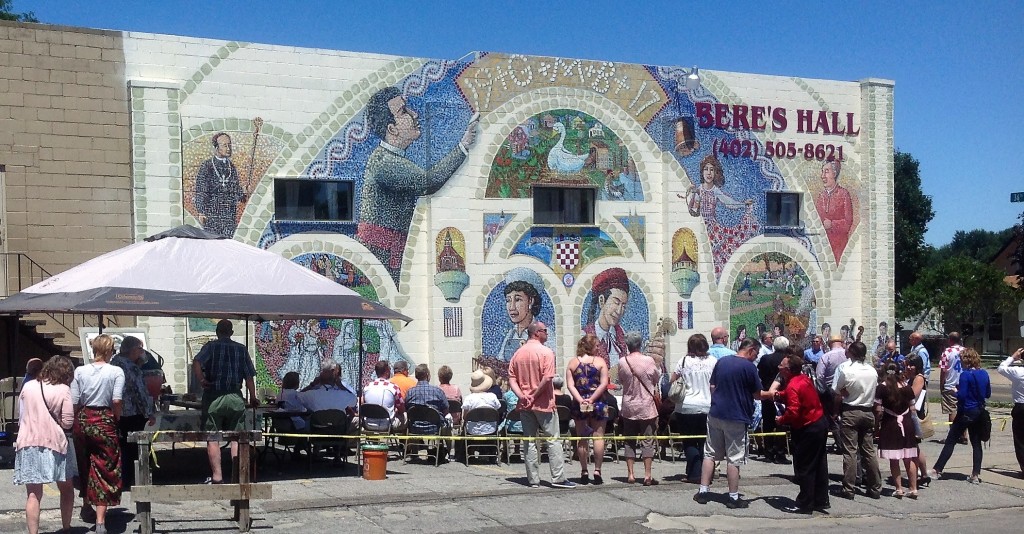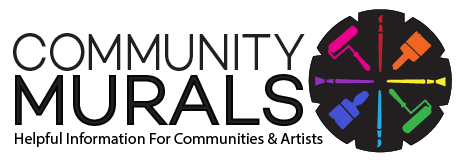

- Please state your name, business name and your current working area (how far are you willing to travel for work). I am Richard Harrison and my company is A Midsummer’s Mural. Most of our community art projects are under the title South Omaha Mural Project. Our working area is usually Omaha and Council Bluffs but we do travel across Nebraska and go to other states for projects as well.
- Do you define yourself as a muralist or simply as an artist? I would define myself as an artist that just loves working large scale.
- What other types of art do you make? I enjoy working on small water colors, acrylic and oil paintings.
- What inspires your artwork when content is not dictated by a client? I am intrigued most by atmospheric effects on landscape, architectural ornament and life drawing. I enjoy trying impressionist painting techniques.
- What was the path that led you to make murals with communities? Was it intentional or did it happen via requests from community? We were contacted for 3 consecutive communities to make public art in their neighborhood before we started reaching out to new communities ourselves. We regularly get requests to continue our work these days.
- Can you recall a specific moment (or moments) that helped you realize you wanted to be a part of making murals with communities? Our first mural where the content of our painting was driven by the community was the 13th Street Bohemian Mural. We delivered flyers about meetings by walking through the neighborhood, had story circles to listen to people talk about their community, and visited with all the business owners up and down the street. People came to help paint on community paint day and our completion celebration was a wonderful celebration on the Bohemian culture and the diverse community that lives with them. I was really impressed by the way art could express the history and feelings of a group of people and bring them together to build friendships and discuss opportunities for ongoing improvements.
- What are the benefits of collaborating with a community to you as a person, as an artist…? Doing community art has enriched my life. I am connected to a growing number of new friends, and know what is deeply important to them. My work makes a difference in peoples’ lives. My future is filled with exciting possibilities. I grow opportunities for others to become engaged with their communities, their talents, and sometimes their artistic careers.
- What do you perceive as being the benefits to the communities (to paint a mural)? Perhaps there are different kinds of benefits during the process vs after the mural is complete? The benefits to a community to paint a mural are many. They get a chance to express their identity; who they are, where they came from, and what’s important to them. They get together in meetings and get to know each other better. Bridges are built between owners of businesses and residents, people who are needing resources and those who can help them. Creative ideas like community gardens and other projects get brainstormed and energized. Problems the community are experiencing get discussed and people feel heard and more hopeful about getting to a better future. Churches, social organizations, and business associations get involved and get an opportunity for awareness of what they offer and how people can use their services. The final product can add color and beauty to walls that once were ugly magnets for graffiti. Youth get new ideas of how to express their creativity and it leads them to better life paths. People feel encouraged to pick up trash, mow grass, keep up the area, and feel proud of where they live.
- What are some key differences in working with a community client versus working with a commercial business or homeowner? In community mural work you are facilitating the community to create a collaborative work of art. It usually takes months of listening and endless trial sketches to be sure you are capturing the imagination of the many participants. In work with a single client you get a few goals from the client to start with and you get to respond with your vision and with a little feedback the project is designed and ready to begin. In community work you are engaging with the community as you work as if you were expressing something very special to them. With a private client you are more typically enhancing a space or creating an ambiance that pleases people. Generally community work is more personal.
- What is your typical process of collaborating with members of a community? Have you developed helpful strategies for working with communities or is each community so different that each one ends up with its own process?While each community feels very different the framework is almost always the same. We have a call for artists for our apprentice and sometimes lead artists. We hand out flyers in the neighborhood about our project. We try to have about 4 story circle meetings where we listen to what is important to the community and their unique history. Then we have about 4 design workshops where we encourage a smaller group of community members to solve the artistic problem of how to compose the ideas on a wall, what colors and textures and lines to use and so on. Then we present the design to everyone who has participated and get a vote to proceed or continue design work. After prepping the wall we project the mural at night. We invite all ages to join us in drawing the projected shapes on the wall. In a day or two we have a community paint day where we give people a chance to paint a few shapes of the mural. Then we work on the project as a team of artists for 6-12 weeks, with a few volunteers popping in from time to time. Our completion celebration usually involves a short speech and lots of traditional foods and live, festive music.
- What challenges have risen in the process, what have been the solutions?
We often have a challenge of getting buy in at first. Usually an individual or a small group feels that they can most efficiently express the thoughts of the community and we can get by without larger gatherings. The solution to this is helping the leaders understand that there are great benefits in having more people engaged, for example that they might become more engaged in other projects the group is doing. It also helps to attend a festival or event in the community and get conversation going about the project there. We have had individuals challenge content the group wants incorporated. Many people think that art should only show the pleasant parts of life but each group has had challenges and we like to include those stories in our murals. In the end the group votes and we try to be diplomatic to everyone. - How have communities found you? Or do you seek them out? If you seek them out, how do they typically respond? We have painted 9 community murals and about half of them have involved us approaching the community first. They are always excited about the possibility, especially when we assure them that we can find funding from outside sources.
- What are your favorite aspects of being part of community murals? The best part of the work is the appreciation people express and the friendships we make.
- What is your dream project? Our next project is always the apple of our eye. In this case it is a mural for the Mayan community of South Omaha. The Mayans have a very beautiful culture and they are a current wave of immigration. Refugees from Guatemala and Honduras are a subject the American people are trying to come to grips with and we are excited to be a part of the conversation!
- What is your advice to artists who aspire to be a muralist? I like to consider that the way we live our lives is a form of art. When we make choices that shape our future that is an artistic choice. I advise everyone to be brave and take chances and remember that we can make beautiful lives that help others and make a difference in the world. Remember that failure means you learned what doesn’t work and you now have the chance to try again with better information. Keep open to all kinds of opportunities because skills like sign painting and decorative finishes can help you with your skills while keeping your income more predictable. Get to know the artistic community in your area. Also, ask for help when you need it and give help when you can.
- What is your advice to artists who aspire to paint community-based murals? Attend meetings and festivals of your community, spend time with them and get to know them. Make sure to invest time in getting out the word for events. Keep good records of conversations and budget. Track when grants are due and do your homework on them so you know what to do and when.
- What is the best way for communities to contact you?
Call anytime at 402-490-7026 or email us at midsummer@cox.net
